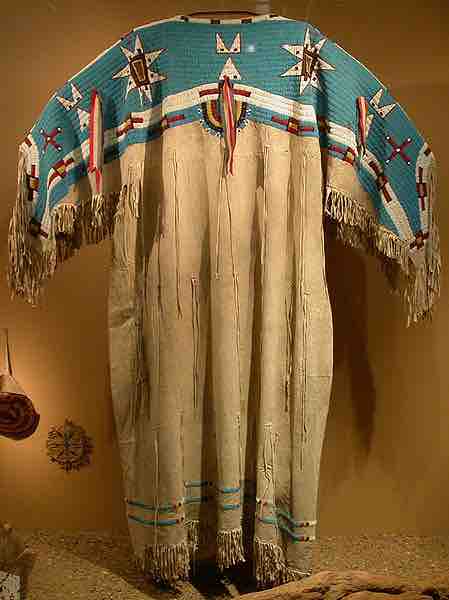Overview: The Great Plains Cultures
The people of the Great Plains are the indigenous peoples who live on the plains and rolling hills of the Great Plains of North America. During the Plains Village period (ca. 950-1850 CE), tribes included nomadic peoples, such as the Blackfoot, Arapaho, Assiniboine, Cheyenne, Comanche, Crow, Gros Ventre, Kiowa, Lakota Sioux, Lipan, Plains Apache (or Kiowa Apache), Plains Cree, Plains Ojibwe, Sarsi, Nakoda (Stoney), and Tonkawa. Tribes also included the semi-sedentary tribes of the Arikara, Hidatsa, Iowa, Kaw (or Kansa), Kitsai, Mandan, Missouria, Omaha, Osage, Otoe, Pawnee, Ponca, Quapaw, Wichita, and the Santee, Yanktonai and Yankton Sioux.
Art of the Great Plains
Buffalo Hides
Buffalo hide has many uses in Great Plains art. Clothing made from buffalo hide was beautiful and elaborate, decorated with porcupine quill embroidery (using a traditional style known as porcupine quillwork), beads, and such prized materials as shells and elk teeth. Later, items such as coins and glass beads acquired from trading were incorporated into Plains art.

Traditional Sioux dress
Sioux dress with fully beaded yoke.
Painting on buffalo hides was a common practice as well. Men painted narrative, pictorial designs recording personal exploits or visions as well as pictographic historical calendars known as Winter counts. Women painted geometric designs on tanned robes and rawhide, which sometimes served as maps. During the Reservation Era of the late 19th century, buffalo herds were systematically destroyed by European hunters. Due to the scarcity of hides, Plains artists adopted new painting surfaces, such as muslin or paper, giving birth to Ledger Art. Ledger Art flourished from the 1860s to the 1920s and was named for the accounting ledger books that were a common source for paper for Plains Native Americans during the late 19th century.
Beadwork
Great Plains Native Americans are most well known for their beadwork, which dates back to 8800 BCE and was used to decorate chokers, breastplates, clothing, jewelry, and ceremonial headdresses worn by women and men. Shells, such as marginella and olivella shells, were traded from the Gulf of Mexico and the coasts of California to the Plains beginning in 100 CE, and mussel shell gorgets, dentalia, and abalone were prized trade items for jewelry. Bones provided material for beads as well, especially long, cylindrical beads called hair pipes. Porcupine quillwork was also used in creating bracelets, hatbands, belt buckles, headdresses, hair roaches, and hairclips.
Glass beads were first introduced to the Plains as early as 1700 and were used in decoration in a manner similar to quillwork, though they never fully replaced it. The Lakota, especially the members of the Standing Rock Sioux tribe in the Western Dakotas, became particularly adept at glass bead work. Several award-winning quillworkers are active in the art world today, such as Juanita Growing Thunder Fogarty (Assiniboine-Sioux).
Metalsmithing
Southern Plains Native Americans adopted metalsmithing in the 1820s, after metal jewelry was introduced through Spanish and Mexican metalsmiths and trade with tribes from other regions. Plains men began wearing metal pectorals and armbands, and in the late 19th and early 20th centuries, members of the Native American Church revealed their membership to others through pins with emblems of peyote buttons, water birds, and other religious symbols. Bruce Caesar (Sac and Fox-Pawnee) is one of the most prolific Southern Plains metalsmiths active today and was awarded the NEA's National Heritage Fellowship in 1998. U.S. Senator Ben Nighthorse Campbell (Northern Cheyenne) is also an accomplished silversmith.